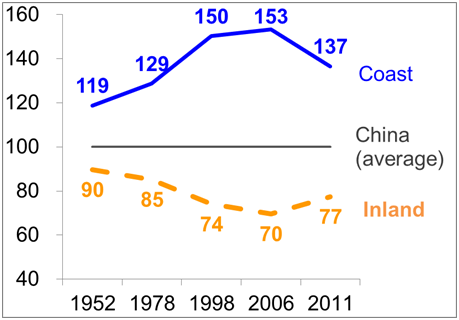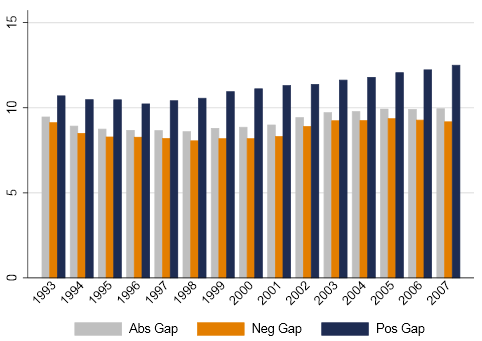Since the early phase of the country modernization, the center of gravity of China’s economy has been alternately located in the coastal area and in inland area. Such a shift is now taking place in China’s economic geography: the interior regions are catching up the coastal area (which was the engine of economic takeoff the last thirty years), thanks to an outstanding convergence speed in industry. This rebalancing goes hand in hand with China’s new growth regime which relies increasingly on its expanding domestic market. Françoise Lemoine, Sandra Poncet, Deniz Ünal >>> |
- Currency turmoil in an unbalanced world economy
Michel Aglietta, Virginie Coudert
- Foreign Language Learning: An Econometric Analysis
Victor Ginsburgh, Jacques Melitz, Farid Toubal - Firm Level Allocative Inefficiency: Evidence from France
Lionel Fontagné, Gianluca Santoni - Has trade openness reduced pollution in China?
José de Sousa, Laura Hering, Sandra Poncet - Atlantic versus Pacific Agreement in Agri-food Sectors: Does the Winner Take it All?
Anne Célia Disdier, Charlotte Emlinger, Jean Fouré - Do Regional Trade Agreements Really Boost Trade? Estimates for Agricultural Products
Sébastien Jean, Jean-Christophe Bureau - Variable Trade Costs, Composition Effects, and the Intensive Margin of Trade
Lionel Fontagné, Antoine Berthou - From Micro to Macro: Demand, Supply, and Heterogeneity in the Trade Elasticity
Maria Bas, Thierry Mayer, Mathias Thoenig - Does Exporting Improve Matching? Evidence from French Employer-Employee Data
Matilde Bombardini, Gianluca Orefice, Maria D. Tito
- Journal of International Economics
Are the benefits of export support durable? Evidence from Tunisia
Olivier Cadot, Ana M. Fernandes, Julien Gourdon, Aaditya Mattoo - Journal of Economic Dynamics and Control
On the Stability of Calvo-style Price-Setting Behavior
Stéphane Lhuissier, Margarita Zabelina - China Economic Review
Spatial rebalancing and industrial convergence in China
Françoise Lemoine, Sandra Poncet, Deniz Ünal - Journal of International Economics
Product standards and margins of trade: Firm-level evidence
Lionel Fontagné, Gianluca Orefice, Roberta Piermartini, Nadia Rocha
AEEF 2016 : 10 years Anniversary Event
September 21 - 22, 2016
XIII ELSNIT Annual Conference : Trade Facilitation
October 23 - 24, 2015
Agriculture, International Trade and Development - 2nd Workshop MAD
November 19 - 20, 2015
Immigration in OECD Countries - 5th Annual International Conference
December 11, 2015
ETSG 2015 - PARIS 17th Annual Conference
September 10 - 12, 2015
French manufacturing firms : a significant increase in the average labour gap Based on firm-level productivity estimates, the study identifies in the gap between the value of the marginal product and marginal input price the output loss due to inefficiencies in inputs allocation. The degree of resource misallocation is calculated among firms within sectors for each of the 96 French "Départements". Over the period 1993- 2007 the average gap at firm level is around 10 thousands euro, showing a relevant increase starting from the early 2000s. Lionel Fontagné & Gianluca Santoni >>> |
This is the average increase in bilateral agricultural and food exports due to regional trade agreements (RTAs). The trade effects of tariff preferences are assessed using difference-in-differences panel estimations, whereby exports to third destinations and imports from third origins are used as benchmarks. The method is applied at a detailed product level for 74 agreements, over the period 1998-2009, for the agricultural and food sector. Sébastien Jean & Jean-Christophe Bureau >>> |
- Contact us
- Our other sites
 |
ISSN: 1255-7072
Editorial Director : Antoine BouëtManaging Editor : Dominique Pianelli













